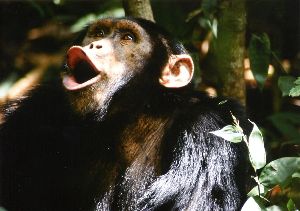|
Eleven-Year Old Male Chimpanzee Outranks Ex-Alpha Adult Male at Bossou
Michio Nakamura (Japan Monkey Centre) and Gaku Ohashi (Kyoto University)
Introduction Dominance among chimpanzees (Pan troglodytes) is usually measured by the pant-grunting vocalization directed from the subordinate to the dominant (1, 2). Although a linear dominance hierarchy exists among most adult males, some dyadic relationships are ambiguous (1, 3). In contrast, there is a distinctive social gap between adult males and adolescent males, i.e. all adolescents pant-grunt to all adults (4). Adolescence in male chimpanzees is thus a period between sexual maturity and social maturity which is achieved at about 15 years of age (5, 6, 7 but see 8). We report here the case of YL, a young male at Bossou, who outranked an old ex-alpha adult male TA and became the beta male at the age of 11 years, and who also showed insubordination to the alpha male FF. Methods Wild chimpanzees have been continuously studied at Bossou, Guinea since 1976. In more than two decades, there has been little change in the group size (8), which is currently 19 including two adult males. Ohashi followed FF for 1210 hours from Jul. 2002 to Mar. 2003, and Nakamura followed 9 individuals including all four of the sexually mature males (Table 1) for 241 hours from Jan. to Mar. 2003. Observations were made during focal follows that included non-focal individuals around the target subjects.  Observations YL (Figure 1) pant-grunted to TA until at least Jan. 2003, but no pant-grunts were heard after that. YL was completely subordinate to FF until early Feb. 2003, showing exaggerated pant-grunts characteristics of adolescent males.  Figure 1. Eleven-year old male Yolo (YL) On 8th Feb. 2003, TA showed sexual possessiveness to an estrous female Fn in the party that included YL, PO and some others. PO copulated stealthily with Fn, which caused great uproar in the party, and YL and TA displayed at each other. Neither pant-grunted, but finally TA grimaced, screamed, and sought assurance from YL. After that, TA groomed first with YL's mother Yo who had rushed to the uproar, and then with YL for about 30 minutes. In the next evening, while TA and YL ate Rhaphiostylis beninensis fruits with six other chimpanzees, TA began to make opportunistic displays around Fn. When Fn screamed, YL also began to display and when YL approached TA, he pant-grunted to YL. On 18th Feb. 2003, TA and PO ranged away from others. When they reunited with YL that evening, TA pant-grunted without YL displaying or showing aggression. As FF was ranging far to the north in consortship with a female from 8th to 21st Feb, it is possible that TA's submissive behavior to YL was temporary, because of the absence of support from FF. However, on 2nd Mar., TA pant-grunted to YL when FF was in the nearby tree, so it was obvious that YL dominated TA and was now the beta male.
After FF's return, YL never pant-grunted to FF except for once on 22nd Feb. YL tended to walk away from FF, but when he met FF he sometimes displayed from a distance of 10-20m standing bipedal and swaying his arms with hair erection. For a while, FF made no aggression against YL's insubordination except for displaying back, but on 12th Mar., FF beat YL out of the tree of Ficus umbellata. Unfortunately, this was the last day of our research at Bossou, so we could not follow further developments.
This report implies that chimpanzee males have the potential to rise in rank earlier than usual, under some conditions such as early physical growth and few social constraints. However, large body size is not enough to attain higher rank, as one male in Mahale, Bembe, had been low-ranking although he was large-bodied. If there are many adult males in the group, older males may skillfully exploit the histories of relationships with other adults to maintain higher social status than the physically developed but young males.
Back to Contents |